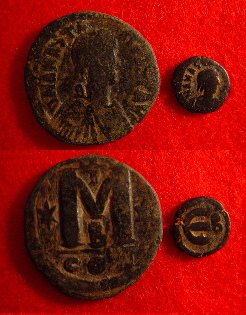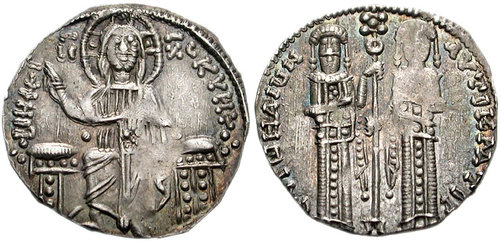|
Hyperpyra
The ''hyperpyron'' (, ''nómisma hypérpyron'' ) was a Byzantine coin in use during the late Middle Ages, replacing the ''solidus'' as the Byzantine Empire's standard gold coinage in the 11th century. It was introduced by emperor Alexios I Komnenos. History The traditional gold currency of the Byzantine Empire had been the ''solidus'' or ''nomisma'', whose gold content had remained steady at 24 carats for seven centuries and was consequently highly prized. From the 1030s, however, the coin was increasingly debased, until in the 1080s, following the military disasters and civil wars of the previous decade, its gold content was reduced to almost zero. Consequently, in 1092, Emperor Alexios I Komnenos ( 1081–1118) undertook a drastic overhaul of the Byzantine coinage system and introduced a new gold coin, the ''hyperpyron'' (meaning "super-refined"). This was of the same standard weight (4.45 grams) as the ''solidus'', but only 20.5 carat purity (0.854 fineness) instead of the stand ... [...More Info...] [...Related Items...] OR: [Wikipedia] [Google] [Baidu] |
Byzantine Coinage
Byzantine currency, money used in the Eastern Roman Empire after the fall of the West, consisted of mainly two types of coins: gold solidus (coin), solidi and Hyperpyron, hyperpyra and a variety of clearly valued bronze coins. By the 15th century, the currency was issued only in debased silver Stavraton, stavrata and minor copper coins with no gold issue. The Byzantine Empire established and operated several Mint (coin), mints throughout its history. Aside from the main metropolitan mint in the capital, Constantinople, a varying number of provincial mints were also established in other urban centres, especially during the 6th century. Most provincial mints except for Syracuse, Sicily, Syracuse were closed or lost to Arab–Byzantine wars, Arab Muslim invasions in the Mediterranean Region by the mid-7th century onwards. After the loss of Syracuse in 878, Constantinople became the sole mint for gold and silver coinage until the late 11th century, when major provincial mints began t ... [...More Info...] [...Related Items...] OR: [Wikipedia] [Google] [Baidu] |
Trachy (currency)
The term ''trachy'' (), plural ''trachea'' (τραχέα), meaning "rough" or "uneven", was used to describe the cup-shaped (incorrectly often called "scyphate") Byzantine coins struck in the 11th–14th centuries. The term was properly applied to coins of electrum, billon (alloy), billon, or copper, and not to the gold ''hyperpyra''. During the short lifespan of the feudal Crusader state, the Latin Empire of Constantinople (1204–1261) also used the trachy. References Sources * Coins of the Byzantine Empire Numismatic terminology {{Byzantine-stub ... [...More Info...] [...Related Items...] OR: [Wikipedia] [Google] [Baidu] |
Andronikos II Palaiologos
Andronikos II Palaiologos (; 25 March 1259 – 13 February 1332), Latinization of names, Latinized as Andronicus II Palaeologus, reigned as Byzantine emperor from 1282 to 1328. His reign marked the beginning of the recently restored empire's final decline. The Turks conquered most of Byzantium's remaining Anatolian territories, and Andronikos spent the last years of his reign fighting his Andronikos III Palaiologos, own grandson in the First Palaiologan Civil War. The war ended in Andronikos' forced abdication in 1328, after which he retired to a monastery for the remainder of his life. Life Early life Andronikos was born on 25 March 1259, at Nicaea. He was the eldest surviving son of Michael VIII Palaiologos and Theodora Palaiologina (Byzantine empress), Theodora Palaiologina, grandniece of John III Doukas Vatatzes. Andronikos was acclaimed co-emperor in 1261, after his father Michael VIII recovered Constantinople from the Latin Empire, but he was not crowned unti ... [...More Info...] [...Related Items...] OR: [Wikipedia] [Google] [Baidu] |
Bezant
In the Middle Ages, the term bezant (, from Latin ) was used in Western Europe to describe several gold coins of the east, all derived ultimately from the Roman . The word itself comes from the Greek Byzantion, the ancient name of Constantinople, the capital of the Byzantine Empire. The original "bezants" were the gold coins produced by the government of the Byzantine Empire, first the and from the 11th century the . Later, the term was used to cover the gold dinars produced by Islamic governments. In turn, the gold coins minted in the Kingdom of Jerusalem and County of Tripoli were termed "Saracen bezants" (), or "fake dinars" (), since they were modelled on the Fatimid dinar. A completely different electrum coin based on Byzantine was minted in the Kingdom of Cyprus and called the "white bezant". The term ''bezant'' in reference to coins is common in sources from the 10th through 13th centuries. Thereafter, it was mainly employed as a money of account and in literary ... [...More Info...] [...Related Items...] OR: [Wikipedia] [Google] [Baidu] |
Silver
Silver is a chemical element; it has Symbol (chemistry), symbol Ag () and atomic number 47. A soft, whitish-gray, lustrous transition metal, it exhibits the highest electrical conductivity, thermal conductivity, and reflectivity of any metal. Silver is found in the Earth's crust in the pure, free elemental form ("native metal, native silver"), as an alloy with gold and other metals, and in minerals such as argentite and chlorargyrite. Most silver is produced as a byproduct of copper, gold, lead, and zinc Refining (metallurgy), refining. Silver has long been valued as a precious metal. Silver metal is used in many bullion coins, sometimes bimetallism, alongside gold: while it is more abundant than gold, it is much less abundant as a native metal. Its purity is typically measured on a per-mille basis; a 94%-pure alloy is described as "0.940 fine". As one of the seven metals of antiquity, silver has had an enduring role in most human cultures. Other than in currency and as an in ... [...More Info...] [...Related Items...] OR: [Wikipedia] [Google] [Baidu] |
Medieval Bulgarian Coinage
Medieval Bulgarian coinage were the coins minted by the Bulgarian Emperors during the Middle Ages at the time of the Second Bulgarian Empire. There is no evidence that coins were minted during the First Bulgarian Empire, and minting ceased after the fall of the Second Empire with Ottoman domination in 1396. They were gold (''perperi''), silver (''aspri''), billon (coinage of silver and copper) and copper coins, all flat and hollow. The inscriptions were usually in Bulgarian language and rarely in Greek. Due to the limited space the inscriptions were abbreviated, often written with a few letters and special signs. Artistically, they continued the Byzantine numismatic tradition but the designs were often more schematic. The main means of expression were lines and dots. The Bulgarian coins had images different from the Byzantine and Slav coinage, so they form a distinct group. The coins are an important source for the history of the Second Bulgarian Empire. Ivan Asen II Tsar ... [...More Info...] [...Related Items...] OR: [Wikipedia] [Google] [Baidu] |
Assarion
The ' (: '), occasionally ''assarius'' (: ''assarii''; ), was a bronze, and later copper, coin used during the Roman Republic and Roman Empire. Republican era coinage The Romans replaced the usage of Greek coins, first by bronze ingots, then by disks known as the ''aes rude''. The system thus named ''as'' was introduced in ca. 280 BC as a large cast bronze coin during the Roman Republic. The following fractions of the were also produced: the (), (), (), (), (), (), (, also a common weight unit), and (), as well as multiples of the ''as'', the (2), (2), and (3). After the ''as'' had been issued as a cast coin for about seventy years, and its weight had been reduced in several stages, a ''as'' was introduced (meaning that it weighed one-sixth of a pound). At about the same time a silver coin, the ''denarius'', was also introduced. Earlier Roman silver coins had been struck on the Greek weight standards that facilitated their use in southern Italy and across th ... [...More Info...] [...Related Items...] OR: [Wikipedia] [Google] [Baidu] |
Tornese
The tornesel, tornesol, or was a silver coin of Europe in the Late Middle Ages and the early modern era. History It took its name from the ', the of Tours. Marco Polo referred to the tornesel in recounts of his travels to East Asia when describing the currencies of the Yuan Empire.Henry Yule''The Travels of Marco Polo: The Complete Yule-Cordier Edition'' Third edition (1903), revised and updated by Henri Cordier. Plain Label Books. p. 1226-27. () His descriptions were based on the conversion of 1 bezant = 20 groats = 133⅓ tornesel. The ' was a subunit of the Neapolitan, Sicilian, and Two Sicilies ducats. See also *History of coins in Italy Italy has a long history of different coinage types, which spans thousands of years. Italy has been influential at a coinage point of view: the medieval Florentine florin, one of the most used coinage types in European history and one of the m ... References Medieval history of Italy Medieval currencies Coins of Italy ... [...More Info...] [...Related Items...] OR: [Wikipedia] [Google] [Baidu] |
Basilikon
The ''basilikon'' (, "imperial oin), commonly also referred to as the (Greek: δουκάτον), was a widely circulated Byzantine silver coin of the first half of the 14th century. Its introduction marked the return to a wide-scale use of silver coinage in the Byzantine Empire, and presaged the total abandonment of the gold coins around the middle of the century. History The ''basilikon'' was introduced shortly before 1304 by Emperor Andronikos II Palaiologos (r. 1282–1328), in direct imitation of the Venetian silver ducat or '' grosso'', chiefly to pay the mercenaries of the Catalan Company... The Byzantine coin closely followed the iconography of the Venetian model, with a seated Christ on the obverse and the two standing figures of Andronikos II and his son and co-emperor Michael IX Palaiologos (r. 1294–1320) replacing St. Mark and the Doge of Venice on the reverse. The similarity was reinforced by the name of the new coin: the ''ducato'', the "coin of the doge", becam ... [...More Info...] [...Related Items...] OR: [Wikipedia] [Google] [Baidu] |
Tetarteron
The ''tetarteron'' (, "quarter [coin]") was a Byzantine Empire, Byzantine term applied to two different coins, one gold circulating from the 960s to 1092 in parallel to the ''histamenon'', and one copper used from 1092 to the second half of the 13th century. Gold coin Ever since Emperor Constantine I (r. 306–337), the Byzantine Empire's main coinage had been the high-quality ''solidus (coin), solidus'' or ''nomisma'', which had remained standard in weight and gold content through the centuries. The Emperor Nikephoros II Phokas (r. 963–969), however, introduced a new coin which was a 2 carats (i.e. about 1⁄12, despite its name) lighter than the original ''nomisma'', which now became known as the ''histamenon''... The exact reason for the introduction of the ''tetarteron'' is unclear. According to the historian Joannes Zonaras, Zonaras, this was done to increase state revenues: the taxes were to be paid as before in the ''histamenon'', while the state paid its own expenses in ... [...More Info...] [...Related Items...] OR: [Wikipedia] [Google] [Baidu] |







